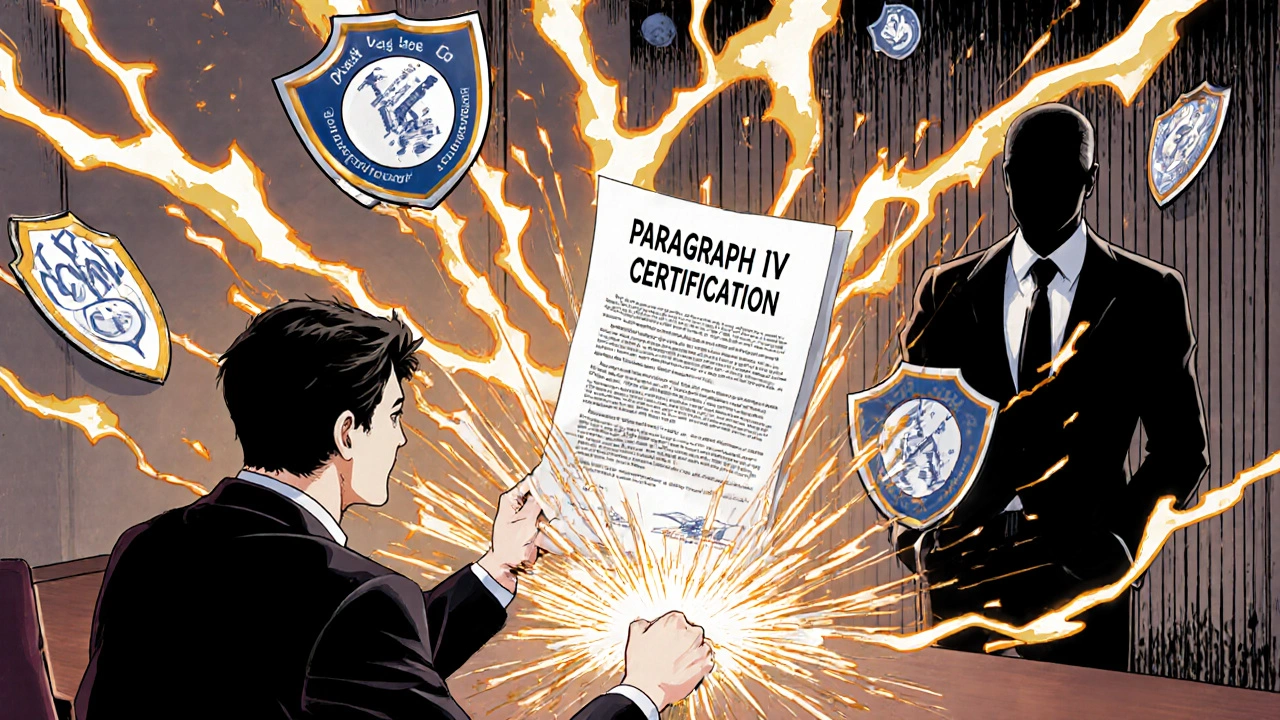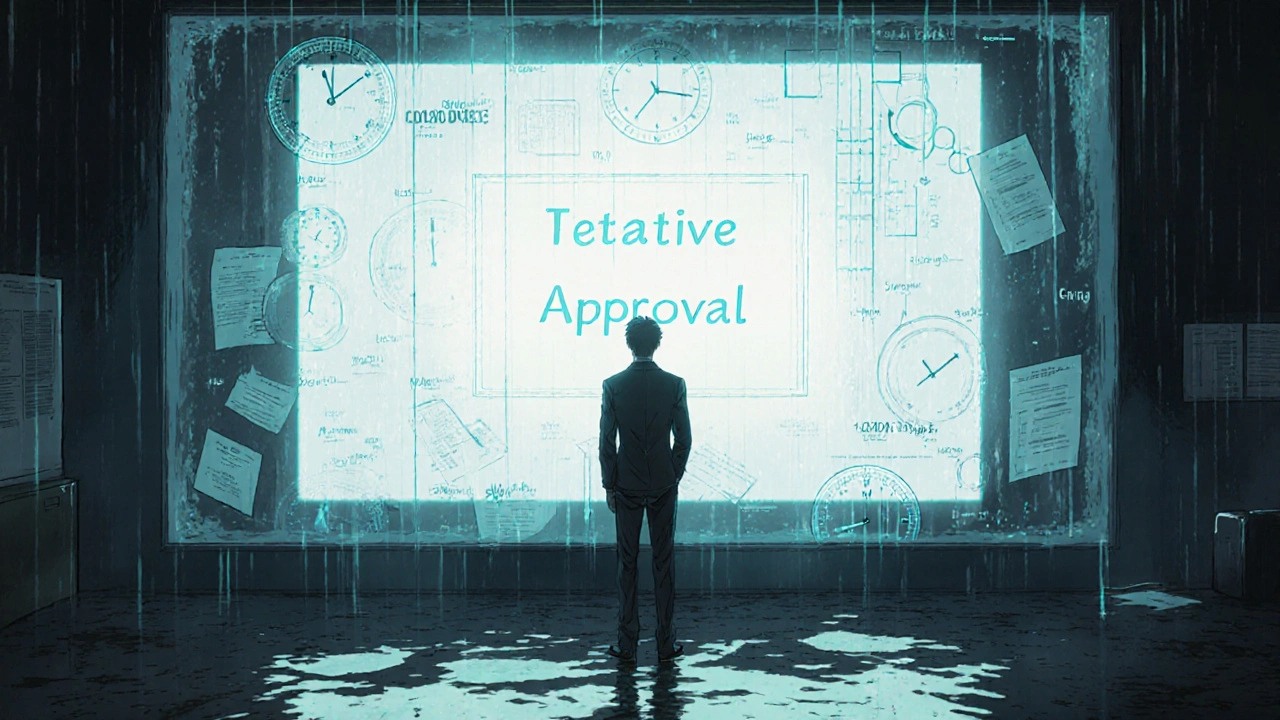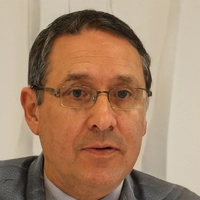When a generic drug company gets tentative approval from the FDA, it’s not a green light to sell its product. It’s a pause button. The science checks out. The manufacturing is solid. The paperwork is clean. But there’s a patent standing in the way. And that patent might not expire for another year-or five. This is the reality for most generic drug makers in the U.S. They don’t wait for the patent to run out and then start applying. They apply while the patent is still active. And then they wait. And they watch. And they prepare.
What Tentative Approval Really Means
Tentative approval isn’t a loophole. It’s a built-in feature of the U.S. generic drug system, created by the Hatch-Waxman Act in 1984. The law was designed to balance two things: protecting brand-name drug companies’ patents and letting generics enter the market as soon as legally possible. Tentative approval is how the FDA handles the middle ground.If your ANDA (Abbreviated New Drug Application) passes every technical review-bioequivalence, stability, labeling, manufacturing-but there’s still an unexpired patent on the brand drug, the FDA doesn’t say no. They say: “We’re ready. Just wait.” That’s tentative approval. It’s a formal notice that your drug is approved in every way except one: timing.
This isn’t just paperwork. It’s a strategic advantage. Companies that get tentative approval lock in their spot in line. When the patent finally expires, they don’t have to reapply. They don’t have to wait months for another review. They just send a quick notice to the FDA and, if everything’s in order, get final approval within 30 days. Some companies have gone from tentative to market in under 24 hours.
The Litigation Gamble: Paragraph IV Certifications
Here’s where things get tense. Most generic companies don’t just wait passively. They challenge the patents. That’s called a Paragraph IV certification. It’s a legal shot across the bow. You’re telling the brand-name company: “Your patent is invalid, or we don’t infringe it.”When you file a Paragraph IV, you trigger a 45-day window for the brand company to sue you for patent infringement. If they do, the FDA is legally required to pause final approval for up to 30 months. That’s called a 30-month stay. It’s a legal timeout. But here’s the twist: if you’re the first company to file a Paragraph IV, you get 180 days of exclusive market access once you finally launch. That’s worth hundreds of millions of dollars.
So companies play a high-stakes game. File early. Get tentative approval. Wait for the patent to expire-or wait for the lawsuit to end. Some settle. Some fight. Some win. Some lose. But if you don’t get tentative approval first, you’re not even in the game.

The Hidden Work: Managing the Wait
A lot of people think once you get tentative approval, you can relax. You can’t. The waiting period is the most dangerous part of the whole process.The FDA requires you to submit any changes to your application-like a new supplier, a tweaked formula, or even a different label design-as an amendment. But there are strict rules. Minor changes? You need to file at least three months before the patent expires. Major changes? Ten months. Miss that deadline, and your final approval gets delayed. Not by days. By months.
One company, Aurobindo Pharma, lost $150 million in revenue because they changed their manufacturing site and didn’t document it properly. Their tentative approval was still valid. Their drug was ready. But the FDA flagged the change. Final approval stalled for four months. The patent expired. The market opened. And they weren’t ready.
Another company, Mylan, got tentative approval for a generic EpiPen. But they didn’t realize the brand company had gotten a six-month pediatric exclusivity extension. That pushed the earliest legal launch date out by half a year. They were sitting on tentative approval for 18 months. But they couldn’t launch until that extra exclusivity period ended. They missed their window.
These aren’t rare mistakes. Evaluate Pharma found that 15% of tentatively approved drugs face delays because of sloppy amendment filings. The FDA doesn’t remind you. They don’t call. They just hold your application until you submit the right paperwork.
Who Uses This System-and Why
This isn’t just for big companies. But it’s mostly used by them. The top 10 generic drug makers each have 15 to 25 products in tentative approval status at any given time. Smaller companies might have two or three. Why? Because the cost of filing an ANDA, hiring legal counsel, and managing the regulatory process runs into millions of dollars. Only companies with deep pockets and strong regulatory teams can play.But the payoff is huge. About 85% of all generic drugs entering the U.S. market today use this tentative approval pathway. And if you’re the first to file a Paragraph IV, you can capture 65% to 80% of the market during your 180-day exclusivity window. That’s how Lupin Limited captured 42% of the Cialis market in the first month after patent expiry in 2018.
Even global health programs rely on it. Companies developing generic HIV drugs under PEPFAR (the U.S. President’s Emergency Plan for AIDS Relief) use tentative approval to secure funding and manufacturing partnerships while waiting for U.S. patents to expire. It’s not just about profit. It’s about access.

What’s Changing in 2025
The FDA is making moves to speed things up. Starting in 2023, they cut the review time for final approval requests from 60-90 days down to 30 days for minor amendments. That’s a big deal. It means if you file on time, you’re likely to launch within weeks of patent expiry.But complexity is rising. More drugs are complex generics-injectables, inhalers, patches-where proving bioequivalence is harder. And patents are getting more layered. Brand companies now file multiple patents covering everything from the pill’s shape to the way it dissolves. Each one can delay entry.
Some lawmakers are pushing to extend patent terms even further. The “Protecting Drug Patents Act,” introduced in March 2023, could add months-or even years-to the wait. If it passes, it could shrink the window for generic companies to launch.
Still, experts agree: tentative approval isn’t going away. Barclays analysts say there’s a 95% chance it’ll still be around in 2030. The Hatch-Waxman Act is too deeply woven into the fabric of the U.S. drug market. The system works. It’s just not easy.
How to Get Started
If you’re a generic drug maker looking to use this system, here’s the real roadmap:- Start with a complete ANDA. No shortcuts. Every section must be flawless.
- Decide: Do you challenge the patent with a Paragraph IV certification? If yes, you’re in for a legal battle-but you might win 180 days of exclusivity.
- Submit your application. Expect the first FDA review to take about 10 months.
- If you get tentative approval, don’t stop. Set up a patent tracker. Monitor every patent and exclusivity period. Use legal and regulatory teams together.
- Three months before the earliest legal launch date, submit your final approval request. No later.
- Keep your manufacturing site in full cGMP compliance. 27% of delays in 2022 came from manufacturing issues.
It’s not a sprint. It’s a marathon with hurdles you can’t see until you’re already running. One misstep, and you lose your place in line. But get it right, and you’re not just launching a drug-you’re capturing a market.
What’s the difference between tentative approval and final approval?
Tentative approval means the FDA has confirmed your generic drug meets all scientific and manufacturing standards-but you can’t sell it yet because of an active patent or exclusivity period. Final approval means the legal barriers are gone, and you’re cleared to market your product immediately. Tentative approval is a placeholder. Final approval is the green light.
Can a generic drug be sold in the U.S. with only tentative approval?
No. Selling a drug with only tentative approval is illegal. The FDA explicitly states that a tentatively approved product is not an approved drug. Companies that try to market it risk enforcement actions, including product seizures, fines, or criminal charges. Tentative approval is a regulatory status, not a commercial license.
How long does it take to get from tentative approval to market entry?
It varies. If your patent expires tomorrow and you’ve already submitted your final approval request on time, you could launch in 30 days. But if you’re waiting for a patent to expire in 18 months, you’re looking at a total timeline of 3 to 5 years from your original ANDA submission. The clock starts when you file the application, not when you get tentative approval.
What happens if the brand company drops its lawsuit?
If the brand company drops the lawsuit or loses in court, the 30-month stay ends immediately. You can then submit your final approval request. The FDA will review it for any outstanding issues, but if your application is clean, you’ll get approval within 30 days. Many companies use this as a strategic trigger-they wait for litigation to resolve before making final preparations.
Do all generic drugs need tentative approval?
No. Only those that face unexpired patents or exclusivity periods. If a brand drug’s patents have all expired and no exclusivity remains, the FDA can grant final approval right away. But in practice, most new generic drugs entering the market today still face at least one active patent-so tentative approval is the norm, not the exception.



14 Comments
Georgia Green
November 17, 2025 AT 14:03i read this and thought wow this is so much more complicated than i thought. i just assumed if the drug was cheap it was ready to go. turns out there's a whole legal chess game going on behind the scenes. and the FDA just sits there like a librarian holding your book until the due date passes.
Christina Abellar
November 18, 2025 AT 16:35This makes so much sense now. I’ve seen generic prices drop overnight and never knew why.
Eva Vega
November 20, 2025 AT 16:25The Hatch-Waxman Act created a regulatory arbitrage mechanism that incentivizes Paragraph IV certifications as a strategic entry point into protected markets. The 180-day exclusivity window functions as a statutory monopoly subsidy, effectively transferring rent from innovators to first-filers. This is not market efficiency-it’s engineered competition.
Matt Wells
November 21, 2025 AT 09:28It is patently obvious that the FDA’s tentative approval protocol represents a gross misapplication of administrative discretion. One cannot, under the auspices of regulatory efficiency, sanction the issuance of a non-binding approval status that functions de facto as a commercial license. This is a legal fiction masquerading as policy.
Peter Stephen .O
November 22, 2025 AT 00:12Imagine being a drug that’s ready to go but stuck in regulatory purgatory. Like a race car with all the fuel and tires but no green light. The patent clock ticks, the lawyers duel, and the company holding the approval? They’re polishing the packaging, training reps, and praying the FDA doesn’t notice they switched a screw supplier. One typo. One missed deadline. And boom-$150M down the drain. This isn’t pharma. It’s a high-stakes thriller with paperwork.
Andrew Cairney
November 23, 2025 AT 01:20They’re lying. All of it. The FDA? Controlled by Big Pharma. The 30-month stay? A backdoor to extend patents forever. That ‘tentative approval’? A trap. You think you’re winning but they’re just waiting for you to invest millions-then they drop a new patent on the pill’s color or the shape of the blister pack. It’s all a racket. I’ve seen the documents. They’re hiding the real patents in Annex 7B of the 2018 FDA guidance. No one talks about Annex 7B. Why? 😈
Rob Goldstein
November 23, 2025 AT 13:19For anyone new to this space-tentative approval is your golden ticket, but only if you treat it like a live wire. The moment you get it, set up alerts for every patent expiration, every exclusivity extension, every supplier change. Miss one amendment window? You’re out. It’s not about being smart. It’s about being obsessive. And yes, the $150M loss at Aurobindo? That’s not an outlier. It’s a warning label.
vinod mali
November 25, 2025 AT 08:35in india we dont have this system. generics come out fast. but i see why usa needs this. its not about stopping generics. its about making sure they dont mess up. still, 15% delay because of paperwork? that’s sad. someone should fix this.
Jennie Zhu
November 26, 2025 AT 11:41The regulatory architecture underpinning the tentative approval paradigm reflects a carefully calibrated equilibrium between intellectual property rights and public health imperatives. The procedural rigor imposed upon applicants is not burdensome, but rather a necessary safeguard against substandard therapeutic substitution. The 30-month stay, while temporally expansive, remains constitutionally defensible under the statutory framework of the Hatch-Waxman Act.
Kathy Grant
November 28, 2025 AT 08:39It’s heartbreaking, really. These companies aren’t just making pills-they’re holding their breath for years. Waiting for a patent to die like it’s a relative in hospice. And when it finally does? They rush in, trembling, hoping their paperwork didn’t get lost in the mail. It’s not business. It’s endurance. And the people who win? They didn’t outsmart the system. They just never stopped showing up.
Robert Merril
November 28, 2025 AT 17:39so you mean the FDA just says "cool we approve your drug" but then says "lol no you cant sell it" for 5 years? and the only way to win is to sue? this system is a joke. someone at the FDA probably has a bingo card for patent loopholes. "oh look another company got tentatively approved. that’s 3 points for me"
Noel Molina Mattinez
November 30, 2025 AT 16:51why dont they just make the patents expire faster why is this so complicated
Roberta Colombin
December 2, 2025 AT 04:01Thank you for sharing this. It’s important to remember that behind every tentative approval is a team working tirelessly to bring affordable medicine to people who need it. This system, while complex, saves lives. Let’s not lose sight of that.
Dave Feland
December 3, 2025 AT 18:17There’s no way this is legal. The FDA is complicit in a cartel. The 180-day exclusivity? That’s not competition-it’s collusion. They’re letting one generic company monopolize the market while blocking others. And the "minor amendments" rule? A smokescreen. Every change is a deliberate delay tactic. I’ve tracked 12 patents on one drug. They’re not protecting innovation. They’re protecting profits.